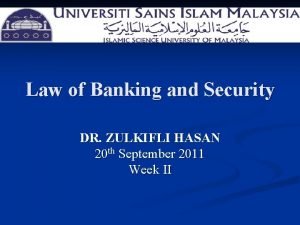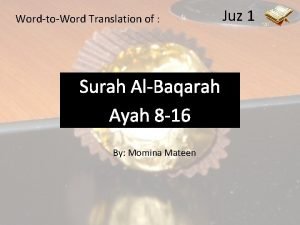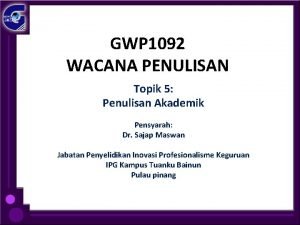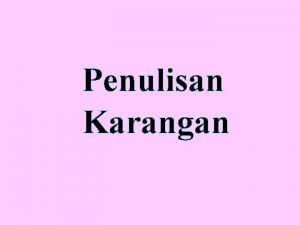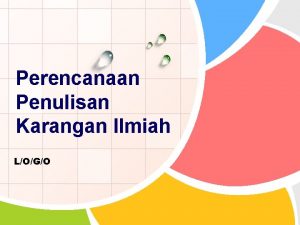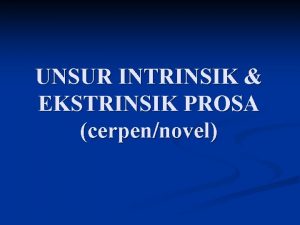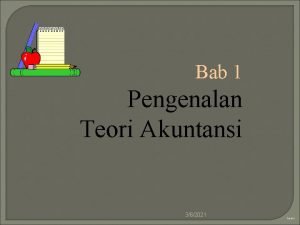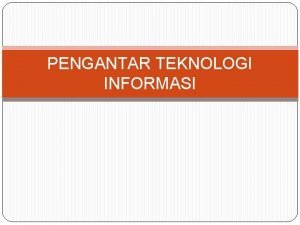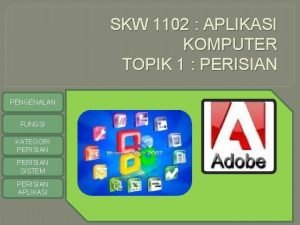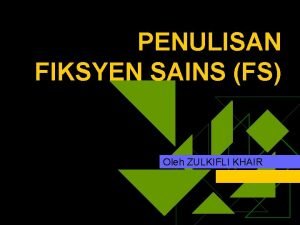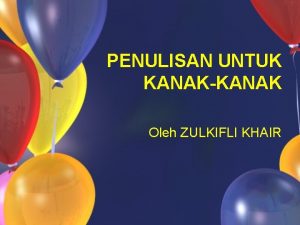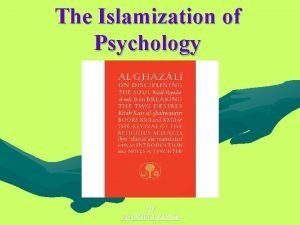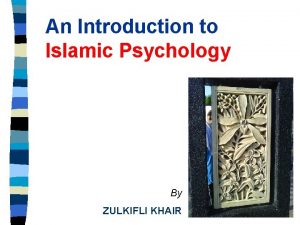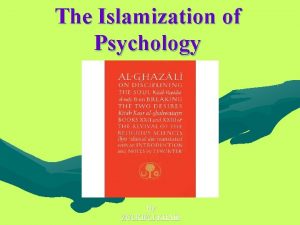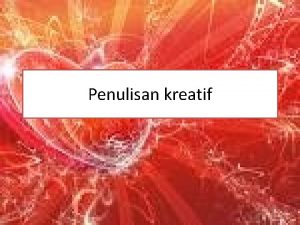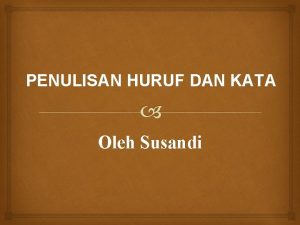PENULISAN NOVEL Oleh ZULKIFLI KHAIR PENGENALAN 1 n












- Slides: 12

PENULISAN NOVEL Oleh ZULKIFLI KHAIR

PENGENALAN (1) n n n Novel berasal daripada kalimat Itali, ‘novella’ bermaksud: perkhabaran baru. Novel terawal dunia, The Tale of Genji (Genji Monogatari) oleh Munasaki Shikibu (1007). 54 bab. Ditulis untuk angkat pemikiran dan sentimen bangsa Jepun. Kisah cinta aristokrat, Hikaru Genji dengan latar istana. Novel Melayu pertama, Hikayat Setia Asyik Dengan Masyuknya atau Hikayat Faridah Hanum (1925&1926) oleh Syed Syeikh al-Hadi (1867 -1934).

PENGENALAN (2) n n n Novel 2 awal Melayu lain termasuk Hikayat Panglima Nikosa (1876) oleh Ahmad Shawal Abdul Hamid dan Kawan Benar (1927) oleh Ahmad Rashid Talu. Jenis 2 novel; picisan, popular dan serius. Contoh novelis popular: Ahadiat Akasyah (Gigolo, Kompilasi Budak Momok dll), Liana Afiera Malik (1, 2, 3…I love You! dll) dll. Falsafah Puitika Sastera Melayu, karya adalah untuk menghibur dan mendidik.

PERBEZAAN NOVEL POPULAR & SERIUS Novel popular Ideologi tak penting. Lojik tak penting. Novel serius Ideologi (termasuk dalam lingkungan jauh) amat penting. Lojik amat penting. Mimpi dan travelogue Surat dikaitkan sering dikaitkan dengan karya serius. dengan karya popular. Perbezaannya amat genting. Cinta Hari-hari Rusuhan terbitan Alaf 21 ialah novel serius; Pemburu Mimpi terbitan DBP ialah novel popular.

LOJIK n Menurut Arena Wati (DS, Disember 1993), lojik mesti ada dalam: l l l n Plot. Watak (termasuk pertalian dengan watak lain, ekepresi gerak, mimik, dialog, monolog). Peristiwa. Lokasi. Watak. Contoh tidak lojik dalam karya: l l 1982. Kapal terbang mendarat di KLIA. Dia berlari ke langit.

IDEOLOGI n Wacana. l l l n n n Wacana sejarah. Wacana agama. Seperti unsur perang budaya. Wacana politik. Intertekstualiti. Lihat 1515 dan 1511 H Kombat oleh Faisal Tehrani. Realisme magis. Berasaskan mitos, gosip, legenda dan berita aneh. New journalism. Lihat Imam oleh Abdullah Hussain dan karya 2 Zaharah Nawawi

Tulislah cerpen dahulu sebelum menulis novel atau skrip drama TV. Tiga li bermula daripada satu langkah.

PERSEDIAAN MENULIS NOVEL n Menurut Dr. Mawar Shafei: l l l n Sensitiviti (alam sekitar, isu semasa dan pembacaan luas). Kreativiti. Pengalaman. Keseriusan. Kerajinan yang luar biasa. Menurut Dr. Fatimah Busu (2003): Bakat semulajadi, sensitiviti yang kuat, pemerhatian yang tajam, daya imaginasi yang unggul dan daya keakalan yang tinggi.

TIP MENULIS NOVEL Tujuan yang jelas. n Tulis apa yang anda benar minat. n Plot dan watak yang jelas. Buat perbincangan. n Banyak membaca. n Siapkan dengan segera. n

Lagi tip 1. You Need An Outline Some people say they can just start writing and it all flows smoothly and evenly to become the perfect piece. If you can write your novel this way, I envy you. (And you probably don't need to read this article)But most people need to form their ideas in some kind of outline. It doesn't have to include every detail of your novel, just the framework. And you can always add and modify as you go along. 2. Point-of-View Decide what point of view you are going to use in a particular scene and stick with it. Don't jump back and forth, it's confusing. Use the "omniscent" viewpoint sparingly and have a limited number of POV characters. Never tell the POV of an insignificant character. 3. Dialogue Read the conversations aloud. Do people you know really talk that way? 4. Dramatic Concept Imagine you are writing the blurb for your novel. Can you sum it all up in just a few sentences? If not, you need a stronger dramatic concept.

5. Tension & Escalation A good story needs conflict but it is equally as important that your conflict escalate. You should gradually build up to that critical level. 6. Show- Don't Tell It's an old saying- but it's true. If a character is angry, don't just SAY she is mad. Put her in a situation that will make her mad and SHOW how she reacts. 7. Obvious Mistakes This is actually one of the most important. No matter how great your word processing program or how many times you proofread yourself, you can always overlook misspellings, grammatical errors and incorrect punctuation. You should have someone very qualified in English or a professional editor proofread your work. If you do not know someone personally, you can hire someone. It is well worth the price. Kredit: http: //www. essortment. com/all/novelwritingti_rsim. htm

NOVEL: HARTA INTELEK YANG AKAN DITINGGALKAN n n Novelis mesti jelas akan tujuan menulis novel, bukan sekadar untuk berhibur atau memaparkan realiti. Novel mesti bertujuan: l l l Mendidik, tapi bukan secara didaktik atau berkhutbah. Menambah perbendaharaan kata dan maklumat budaya. Memupuk pemikiran, kemahiran dan budaya positif; pemikiran inovatif, kemahiran insaniah budaya niaga, budaya R&D dll.
 Dr zulkifli hasan
Dr zulkifli hasan Jazakallah khair plural
Jazakallah khair plural Telnn
Telnn Wacana penulisan ipg
Wacana penulisan ipg Huraian karangan
Huraian karangan Contoh penulisan kreatif
Contoh penulisan kreatif Pengertian perencanaan tulisan
Pengertian perencanaan tulisan Unsur intrinsik novel pasar karya kuntowijoyo
Unsur intrinsik novel pasar karya kuntowijoyo Cpi formula
Cpi formula Pengenalan teori akuntansi
Pengenalan teori akuntansi Pengenalan perkakasan komputer
Pengenalan perkakasan komputer Pengenalan teknologi informasi
Pengenalan teknologi informasi Pengenalan aplikasi komputer
Pengenalan aplikasi komputer
